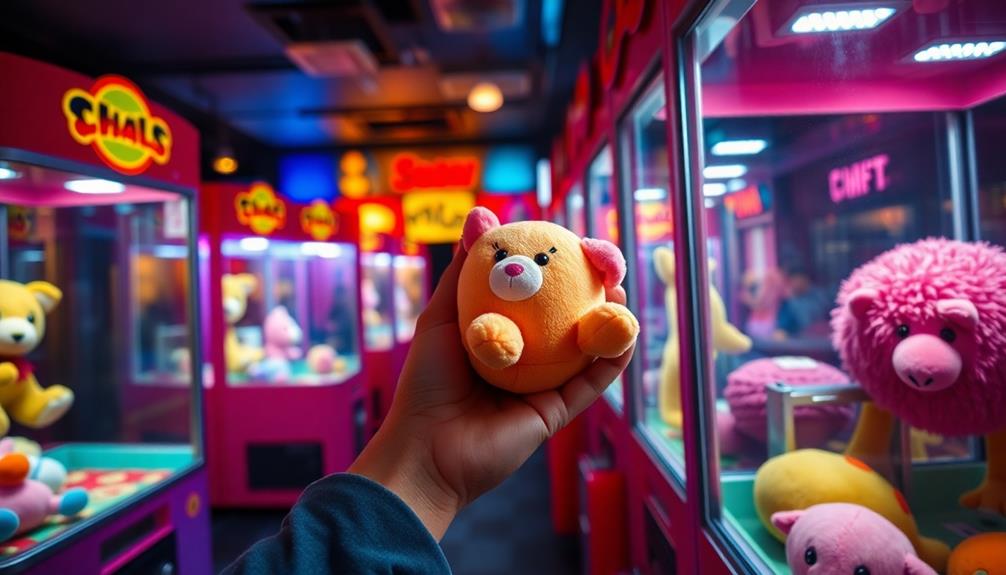Not all arcade games are rigged, but many, particularly claw machines, are programmed to benefit the establishment. Operators have the ability to adjust the grip strength and payout rates, increasing the difficulty of winning. In reality, the success rates for claw machines typically range from 1 in 12 to 1 in 18 attempts. This manipulation leads to frustration and a perception of unfairness among players. While some games require skill, others rely solely on luck. If you are interested in learning more about these tactics and how to enhance your odds of success, continue delving into the subject for further insights.
Key Takeaways
- Not all arcade games are rigged; some are based on skill, while others rely purely on chance.
- Claw machines often have manipulated mechanics, with low success rates due to weak grip strength.
- Operators can adjust payout rates to limit wins, creating a perception of rigging in certain games.
- Player awareness of rigging practices is increasing, leading to skepticism about fairness in arcade games.
- Fair play standards and transparency are being advocated to ensure accountability and restore trust among players.
Overview of Arcade Game Mechanics
When you step into an arcade, understanding the mechanics behind the games can enhance your experience. Arcade games fall into two primary categories: games of chance and games of skill. Claw machines are a prime example of the latter, but their mechanics often mislead players.
Operators manipulate grip strength to influence outcomes, making it difficult to win. Many claw machines are set to yield low winning probabilities, with success rates averaging about 1 in 12 to 1 in 18 attempts. As seen in best rated pinball machines of 2024, operators adjust the claw's pressure and movement settings to maintain control over these odds, optimizing profit margins while minimizing payouts. This means that, despite your best efforts, you might find it more challenging to snag that plush toy than you anticipated.
Players frequently operate under the assumption that claw machines offer fair skill challenges. However, the reality is more complex. Manuals for these machines, available online, reveal the operational settings that can rig the games in favor of the house.
The Truth About Claw Machines

When you approach a claw machine, it's easy to think skill plays a big role, but that's not the whole story. Many machines are rigged with settings that limit your chances of winning, often making success feel more like luck than skill.
For instance, the payout rate can be adjusted, meaning that the machine only allows a certain number of wins over a period of time, much like the way yoga for back pain emphasizes specific poses to manage discomfort.
Understanding these rigging mechanisms can help you navigate your experiences and decide whether you want to trust the game.
Rigging Mechanisms Explained
Claw machines might promise a fun challenge, but the reality is they're often rigged to favor the house. When you step up to play claw games, you might think your skill will earn you that coveted prize. However, the claw's grip strength is usually set too weak, often operating between 5-8 PSI, which isn't enough to consistently lift toys.
This situation mirrors the celebrity world where public perception often masks underlying truths; for example, celebrity relationships can appear perfect but may have hidden complexities.
Even if you manage to snag something, many machines are programmed to weaken the grip strength after a short duration. This means the longer you play, the harder it becomes to win. You might even find that the success rates are manipulated, with manuals indicating odds as low as 1 in 12, depending on the settings chosen by the operator.
This lack of transparency has made players increasingly skeptical about claw games. As public awareness of these rigging practices grows, it's crucial to recognize that the odds are often stacked against you.
Player Awareness and Trust
Trust in arcade games, especially claw machines, has been eroded as players uncover the truth behind their mechanics. You might feel frustrated when you see that despite multiple attempts, winning is elusive. Increasingly, players share their experiences with low success rates—often needing around 18 tries to secure a prize. This has led to skepticism about whether these games are fair at all.
Additionally, the significance of quality assurance in software development highlights how transparency and reliability are essential, much like fair play in arcade games significance of quality assurance.
Here are some key points to reflect on:
- Claw machines often have adjustable settings that operators can manipulate.
- The claw's grip strength is typically set weak, making it difficult to win.
- Public awareness is rising, driven by videos and reports exposing rigged mechanics.
With discussions around ethical concerns growing, it's vital for the arcade industry to restore trust. Industry groups are now pushing for transparency and fair play standards to guarantee you can enjoy your experience without wondering if the game is rigged.
As players, you should advocate for fair practices and hold arcade operators accountable. If you want to enjoy your time at the arcade, remember to play Pledge: commit to being informed and aware of the mechanics behind your favorite games.
Popular Games of Chance

Arcade games of chance entice players with the thrill of potential winnings, but many are designed with profitability in mind rather than fair play. Popular games like claw machines and coin pushers often have mechanics that guarantee operators make a profit.
In claw machines, the grip strength is adjustable, and operators typically set it to a range where the success rate is about 1 in 12 to 1 in 15 attempts. This means you might feel lucky, but your chances of winning are slim. Coin pushers, on the other hand, are engineered to release a specific amount of cash or prizes over time, creating an illusion of higher winning chances.
| Game Type | Odds of Winning |
|---|---|
| Claw Machine | 1 in 12 to 1 in 15 |
| Coin Pusher | Fixed payout rate |
Many operators don't provide clear information about these odds, leaving players unaware of how rigged these games can be. While they may look fun, understanding the mechanics behind these games can save you time and money on your next arcade visit.
Understanding Skill-Based Games

While many arcade games rely on chance, skill-based games offer a different experience that rewards your abilities. In these games, like Fish Bowl Frenzy, you can earn tickets that you can exchange for prizes, emphasizing your skill over luck.
You'll find that skilled players accumulate ticket rewards more consistently than those playing chance-based games, such as claw machines. Additionally, optimal angles for pinball machines can enhance your gameplay performance, making your skills even more essential.
Here are a few benefits of skill-based games:
- Transparent Payouts: Regulations often require clear payout percentages, so you know your chances of winning based on your performance.
- Mastery Matters: These games are designed to reward practice and mastery, allowing you to improve your skills and enhance your success rate.
- Higher Engagement: The gaming industry thrives on skill-based games, attracting players willing to invest time and money for better odds.
In essence, skill-based games provide a more engaging arcade experience. They empower you to leverage your abilities for tangible rewards, making your time spent at the arcade more rewarding and enjoyable.
Cultural Perception of Rigging

You might find yourself torn between the nostalgia of playing arcade games and the trust issues that come with their perceived rigging.
Recent discussions about the importance of a supportive environment in creative endeavors can be paralleled in the arcade gaming world, where a fair and transparent atmosphere can enhance the experience.
While the thrill of claw machines keeps you coming back, it's hard to ignore the skepticism fueled by social media and your own experiences.
As discussions about transparency in gaming practices grow, it's worth considering how these factors shape your view of fairness in arcade gaming.
Nostalgia and Trust Issues
For many, the thrill of claw machines evokes a rush of nostalgia, but this fondness often collides with a nagging suspicion of rigging. You may remember the excitement of trying to snag a plush toy, but social media discussions—like those viral TikTok videos—have raised awareness about adjustable claw strength, intensifying trust issues.
The childhood perception of arcade games as skill-based challenges clashes with the reality that many mechanics are rigged, leading to disappointment when you realize your efforts might be futile. This tension can be likened to the emotional dysregulation experienced by individuals with Borderline Personality Disorder (BPD), where the thrill of connection is often overshadowed by fear and skepticism.
Cultural differences also play a role in shaping these experiences. In Japan, for instance, the robust merchandising practices create a different level of trust compared to other regions. As skepticism about the integrity of arcade games increases, the industry faces a challenge in rebuilding consumer confidence and showing that not all games are rigged.
- Nostalgia can enhance the gaming experience.
- Trust issues can stem from the gap between perception and reality.
- Cultural practices can influence player expectations and experiences.
Ultimately, while nostalgia pulls you in, trust issues may keep you at bay, complicating your relationship with arcade games.
Transparency in Gaming Practices
Transparency in gaming practices is crucial for restoring trust among players. Many of you have likely noticed that arcade claw machines often seem rigged, with adjustable claw strength settings resulting in low success rates. This can make you feel like winning is nearly impossible, contributing to the belief that these arcade games are manipulated.
Just as mastering the art of bug out bags requires clear guidelines and transparency in what to include, the arcade industry must establish clear practices to regain player confidence.
Recent viral content, like that TikTok video exposing adjustable success rates, has amplified skepticism about fairness in arcade games. Legal battles, such as the lawsuit against Sega regarding the Keymaster game, further fuel this distrust. As a result, the arcade industry faces increasing pressure to be transparent about their practices.
To combat these perceptions, industry trade groups are stepping in with fair play pledges. These initiatives aim to guarantee that skill is the main determinant of outcomes, rather than hidden manipulations.
The ongoing dialogue about transparency in gaming practices is crucial; it helps you, the player, understand what to expect and fosters a more ethical environment. By addressing concerns and increasing accountability, the arcade industry can work towards rebuilding your trust and improving your gaming experience.
Insights From Social Media

Social media, especially TikTok, has become a vibrant platform for revealing the often questionable practices behind arcade games. Viral videos, like Katie Clark's, have highlighted adjustable claw strength in claw machines, confirming what many players suspected.
You'll find that TikTok users actively share their experiences, discussing rigged claw machines while admitting they still play for fun. This phenomenon draws parallels to how trust issues with boyfriends can arise from inconsistent behaviors, reflecting a broader theme of manipulation in various aspects of life.
Here are a few insights from the community:
- Many players are aware of the manipulation but enjoy the challenge.
- Humorous videos often express the shared frustration of losing to a rigged game.
- The conversation about arcade ethics is growing, pushing for more transparency.
These discussions reflect a deeper understanding of the addictive nature of arcade games, even when the outcomes seem unfair.
The blend of humor and frustration in these viral moments shows a community grappling with the reality of gaming mechanics. As awareness spreads, players are calling for integrity in how these games operate, highlighting the disconnect between what they perceive and the actual claw strength used in these machines.
This phenomenon is reshaping the conversation around arcade ethics and player experiences.
Regulatory Standards in Arcades

Regulatory standards in arcades play an essential role in shaping the experience players have with games of chance and skill. These standards vary by location, and understanding them can enhance your gaming experience. For instance, in California, claw machines have a winning chance of 1 in 12, while in Nevada, it's set at 1 in 15. These state-specific regulations on payout odds influence how games are designed and managed.
Additionally, knowing your investment goals can help you assess the potential returns and risks associated with arcade gaming. Many jurisdictions require arcade operators to disclose payout percentages, so you can make informed decisions about the games you play. Knowing the average returns over time can help you gauge which games offer fair chances.
The American Amusement Machine Association (AAMA) has also implemented a fair play pledge, ensuring all redemption games provide fair winning chances based on skill rather than manipulation. However, industry self-regulation often raises concerns, with calls for stricter legal oversight to guarantee fairness in game outcomes.
This oversight aims to protect your interests against deceptive practices that might undermine the arcade experience. By being aware of these regulatory standards, you can navigate the arcade landscape more confidently and enjoy your time playing.
Player Experiences and Frustrations

Many players find themselves frustrated with claw machines, often feeling that these games are rigged against them. With an average of 11 out of 12 attempts ending in failure, it's no wonder you might feel disheartened. The grip of the claw often seems weak, letting your prize slip away at the last moment.
Viral TikTok videos, like Katie Clark's, have brought attention to adjustable claw strength, making players feel manipulated and fueling suspicions about the game's fairness.
Yet, despite knowing the odds, you might still find yourself drawn to the allure of claw machines. This addictive nature keeps you coming back, even when you limit your attempts to 3-5 for those highly desired items.
To enhance your experience with claw machines, consider these tips:
- Observe before playing: Watch how others fare to gauge the machine's quirks.
- Target smaller prizes: They often have better odds and can be easier to grab.
- Set a budget: Manage your spending to prevent frustration from overspending.
Ultimately, claw machines can be a mix of fun and frustration, leaving you questioning whether the odds are truly in your favor.
Ethical Considerations in Gaming

Ethics in gaming has become a hot topic, especially when it comes to arcade games like claw machines. You might feel frustrated when you realize that many of these games are rigged, with adjustable settings that limit your chances of winning. This raises serious ethical considerations in gaming, particularly around fairness and transparency.
| Key Issues | Impact on Players |
|---|---|
| Rigged Mechanics | Feelings of deception |
| Lack of Accountability | Erosion of trust |
| Consumer Rights | Demand for transparency |
| Ethical Standards | Push for fair play regulations |
Arcade operators often manipulate claw strength to maximize profits, leading to questions about the integrity of these games. When players expect to win based on skill, discovering that the odds are stacked against them can damage the industry's reputation. Recent efforts by major arcade brands to implement fair play standards aim to restore trust. Legal actions, like the lawsuit against Sega for deceptive practices, emphasize the importance of accountability and protecting consumer rights. Ultimately, ensuring ethical standards in gaming can enhance player experiences and foster a more trustworthy gaming environment.
Frequently Asked Questions
Why Are Arcades Allowed to Rig Games?
Arcades are allowed to rig games mainly because they fall under games of chance regulations. These rules let operators adjust odds for profitability, often prioritizing their margins over player fairness, which can create a frustrating experience for you. This is why arcades rig games to ensure that they make a profit, even if it means manipulating the odds to make it difficult for players to win. As a result, many players have become disillusioned with arcades and their rigged games, leading to a decline in patronage. This practice has also led to calls for stricter regulations and oversight to protect consumers from unfair gaming practices. In response to concerns about arcade game rigging, some jurisdictions have implemented laws to prevent operators from excessively manipulating game odds. These regulations aim to promote transparency and fairness in the gaming industry, ensuring that players have a more enjoyable and equitable experience. However, despite these efforts, arcade game rigging continues to be a contentious issue, prompting ongoing debate and advocacy for further reforms to address player concerns.
Are Arcade Grabbers Rigged?
When you approach a claw machine, it feels like a treasure chest locked tight. Yes, arcade grabbers are often rigged, with operators adjusting grip strength, making your chances of winning as slim as a whisper in the wind.
Are Arcade Key Machines Rigged?
When you play arcade key machines, you might notice low success rates and adjustable settings that could affect your chances. These factors can create doubts about their fairness, making it feel like they're rigged against you.
Are Penny Falls Machines Fixed?
Penny falls machines often have manipulated odds, so you're likely to find it tough to win. Operators set them to retain most of the coins, creating a perception of chance that favors the house.
Conclusion
In the end, while not all arcade games are rigged, the thrill of chasing that elusive jackpot can feel like a modern-day Sisyphean struggle. You might find yourself caught between skill and chance, hoping for a win that sometimes seems just out of reach. Remember, each game offers a unique experience, but it's the fun and camaraderie that truly matter. So, embrace the excitement, and let the games remind you of life's unpredictable joys.









